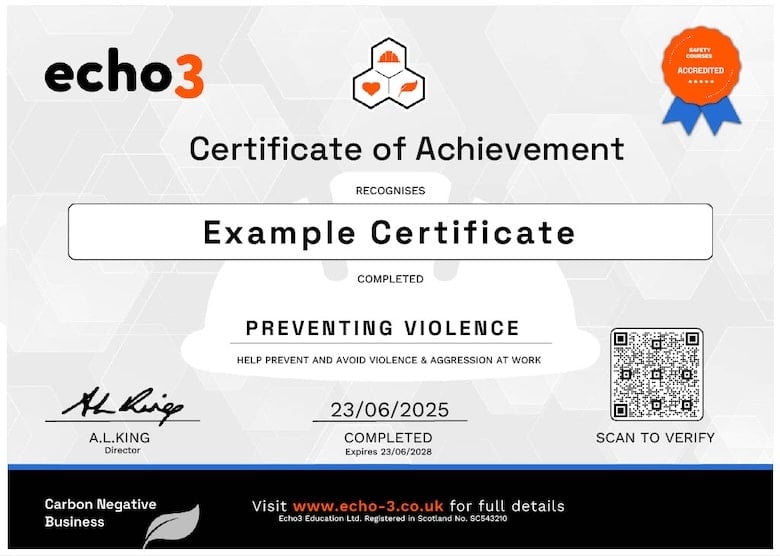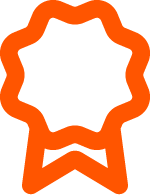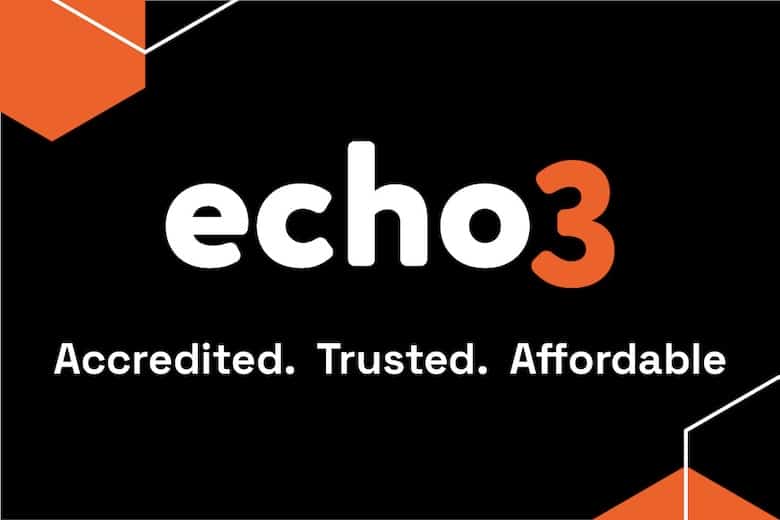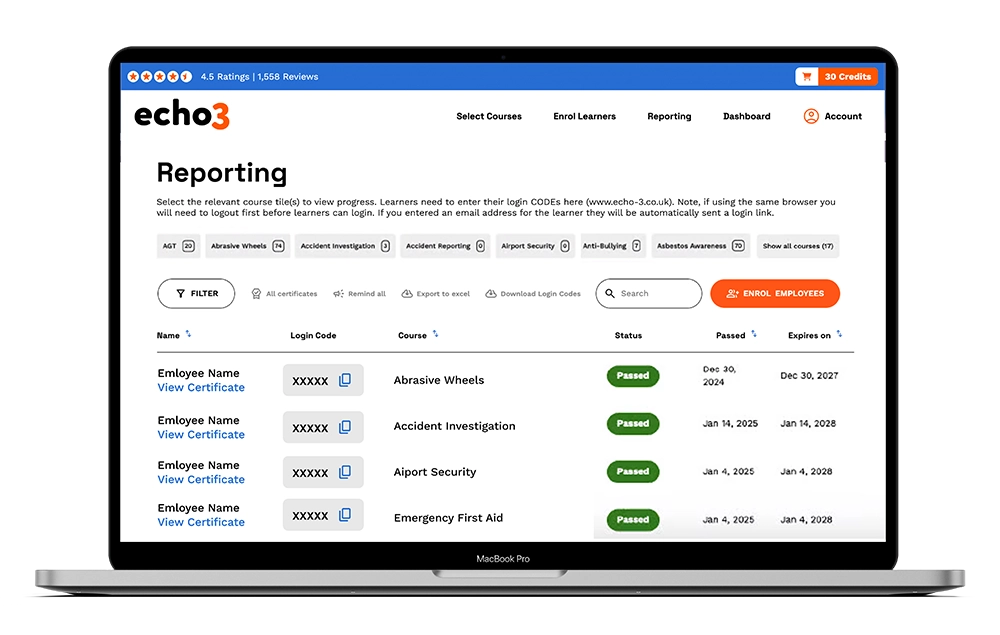Preventing Violence at Work Course
Violence and aggression at work includes any incident in which an employee is abused, threatened, or assaulted in circumstances related to their work.
This can range from physical attacks to verbal abuse, threats, harassment, bullying, and other forms of aggressive behaviour. These incidents can arise from interactions with customers, clients, co-workers, or supervisors.
Understanding the various forms of workplace violence and aggression is the first step towards identifying and preventing these behaviours. Recognising the root causes, such as stress, poor working conditions, or personal issues, can also aid in developing effective prevention strategies.
This course takes approximately 40 minutes to complete and offers a fast, cost-effective way for employers to train staff and certify their understanding of workplace safety.
By choosing the ‘Team’ purchase option, employers also receive free access to our Learning Management System, making it easy to manage and track staff training.
Preventing Violence Course Content
Unit 1 – Introduction to Preventing Violence at Work
This unit provides essential background knowledge to help prevent violence and aggression in the workplace. It explores what violence and aggression at work look like, provides common examples, outlines the relevant legal frameworks, and explains the roles and responsibilities of both employers and employees in maintaining a safe work environment.
Unit 2 – Assessing the Risk
In this unit, we explain how to assess the risk of violence and aggression in the workplace, including what a risk assessment involves and how to identify potential hazards.
Unit 3 – Preventing Violence at Work
In this third unit, we explore how both you and your employer can help prevent violence and aggression in the workplace through a range of strategies and preventive measures. Topics include effective workplace and job design, job-specific training, and techniques such as de-escalation and breakaway strategies.
We also examine industry-specific examples and solutions across sectors like retail, education, social care, healthcare, and transport. Additionally, the unit addresses various forms of workplace violence, including verbal abuse and threats, physical and armed assaults, armed hold-ups, and bomb threats.
Unit 4 – Reporting and Learning
In this fourth unit, we focus on the importance of reporting incidents of violence and aggression in the workplace to support continuous learning and the improvement of preventive measures. We cover why it is essential to report such incidents, what must be reported under regulations such as RIDDOR, and how to accurately record violent incidents.
Unit 5 – Quiz
The Preventing Violence at Work course concludes with a 10-question multiple-choice quiz, allowing participants to demonstrate their understanding of the key learning objectives.
A score of 80% or higher is required to pass. The quiz can be retaken if needed, and upon successful completion, the Echo3 Preventing Violence at Work certificate is emailed directly to the participant.
Preventing Violence at Work Certificate

Download and Print Your Certificate
- Written in compliance with the Health and Safety at Work Act
- Developed by qualified health and safety professionals
- Accredited by CPD – learn more about CPD here
- Last Updated February 2025
- To gain the certificate you must complete the assessment which involves 10 questions.
- The online Preventing Violence at Work certificate is valid for 3 years.
Course Preview
Echo3 courses include engaging motion-graphic video content, with full english subtitles
Reviews
How to Get Certified in 3 Steps
Individual Learners


Benefits for Individuals
-
Engaging video-based content
-
Learner dashboard included
-
Instant access after payment
-
Free course retakes
-
Shareable digital certificate
 QR Code Certificate
QR Code Certificate




Bulk Buying Discounts
What is Violence & Aggression at Work
Violence and aggression at work includes any incident in which an employee is abused, threatened, or assaulted in circumstances related to their work. This can range from physical attacks to verbal abuse, threats, harassment, bullying, and other forms of aggressive behaviour.
These incidents can arise from interactions with customers, clients, co-workers, or supervisors. Understanding the various forms of workplace violence and aggression is the first step towards identifying and preventing these behaviours. Recognising the root causes, such as stress, poor working conditions, or personal issues, can also aid in developing effective prevention strategies.
Examples of workplace violence and aggression include physical attacks, verbal threats, harassment, and bullying. These incidents can occur in various settings, from offices to public service environments.
For instance, a retail worker might face verbal abuse from a dissatisfied customer, while a healthcare worker could encounter physical aggression from a patient. Recognising these behaviours and understanding their impact is crucial for early intervention and prevention.
Creating an environment where employees feel safe to report such incidents is essential for a healthy workplace culture. Providing training on recognising and dealing with these incidents can empower employees to act promptly and appropriately.
What are employee responsibilities?
Employees play a crucial role in maintaining a safe work environment by adhering to workplace policies and procedures, participating in training sessions, and reporting any incidents of violence or aggression.
Employees should take care of their own health and safety, and that of others who may be harmed by their actions at work.
They should be vigilant in recognising early signs of potential threats and take appropriate action to defuse situations or seek help. Employees should support colleagues who may be affected by violence or aggression and contribute to creating a positive workplace culture where safety is a shared priority.
By working together and maintaining open communication, employees can help prevent incidents and ensure a safer, healthier work environment for everyone.
What are employer responsibilities?
Employers have a duty to provide a safe work environment by implementing measures to prevent violence and aggression. This includes developing and enforcing workplace policies, providing training, and supporting employees affected by such incidents.
What are strategies for preventing violence at work?
Workplace Design
Workplace design plays a crucial role in preventing violence and aggression.
Effective design strategies include improving visibility through open layouts and adequate lighting, controlling access to certain areas with secure entry systems, and ensuring that workstations are arranged to allow for easy escape roots if needed.
Incorporating surveillance systems like CCTV can also act as a deterrent and provide evidence in case of incidents.
Regularly reviewing and updating the workplace design to address emerging risks and incorporating feedback from employees can significantly enhance safety. Thoughtful design can reduce the likelihood of violent incidents and promote a secure working environment.
Job Design
Job design involves structuring roles and responsibilities in a way that minimises the risk of violence and aggression.
This can include creating;
- clear job descriptions,
- providing adequate training,
- and ensuring manageable workloads to reduce stress.
- Rotating staff in high-risk areas
- ensuring that employees are not working alone can also mitigate risks.
Regularly reviewing job roles and seeking employee feedback can help identify areas for improvement and ensure that the job design remains effective in promoting safety.
What are the preventing violence course objectives?
The general objective of this Preventing Violence course is to equip employees with the knowledge needed to identify, prevent, and manage the risks from violence and aggression while at work.
The specific learner objective includes
- Understanding the laws around violence and aggression at work.
- How to recognise the risk factors that increase the chance of violence or aggression at work.
- How staff can add simple & appropriate preventive measures into their day-to-day work.
- And, the importance of reporting incidents to improve safety.
Related courses
Communication Skills – How to communicate clearly and professionally at work
Delegation Skills – How to delegate Tasks effectively at work
First Aid at Work – Learn the fundamentals of first aid
Lone Working – How to work safely when lone
Risk Assessment – how to access risks at work.















